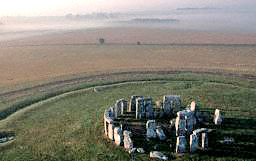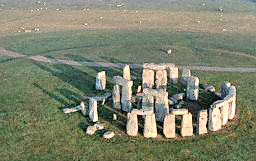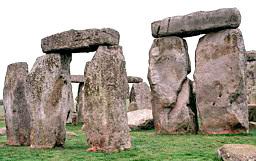|
FOREWORD
"Since the earliest times,
Earthlings have lifted their eyes into
the heavens. Awed as well as fascinated, Earthlings learned the Ways
of Heaven: the positions of the stars, the cycles of Moon and Sun,
the turning of an inclined Earth. How did it all begin, how will it
end - and what will happen in between?
"Heaven and Earth meet in the horizon. For millennia
Earthlings have
watched the stars of the night give way to the rays of the Sun at
the meeting place, and chose as a point of reference the moment when
daytime and night-time are equal, the day of the Equinox. Man, aided
by the calendar, has counted Earthly Time from that point on.
"To identify the starry heavens, the skies were divided into twelve
parts, the twelve houses of the zodiac. But as the millennia rolled
on, the "fixed stars" seemed not to be fixed at all, and
the Day of
the Equinox, the day of the New Year, appeared to shift from one
zodiacal house to another, and to Earthly Time was added Celestial
Time - the start of a new era, a New Age.
"As we stand at the threshold of a
New Age, when sunrise on the day
of the spring equinox will occur in the zodiacal house of Aquarius
rather than, as in the past 2,000 years, in the zodiacal house of
Pisces, many wonder what the change might portend: good or evil, a
new beginning or an end - or no change at all?
"To understand the future we should examine the past; because since
Mankind began to count Earthly Time, it has already experienced the
measure of Celestial Time - the arrival of New Ages. What preceded
and followed one such New Age holds great lessons for our own
present station in the course of Time."
Return
Chapter One
THE CYCLES OF
TIME
"It is said that
Augustine of Hippo, the Bishop in Roman Carthage
(A.D. 354 - 430), the greatest thinker of the Christian Church in
its early centuries, who fused the religion of the New Testament
with the Platonistic tradition of Greek philosophy, was asked, "What
is time?" His answer was, "If no one asks me, I know what it is; if
I wish to explain what it is to him who asks me, I do not know."
"Time is essential to Earth, and all that is upon it, and to each
one of us as individuals; for, as we know from our own experience
and observations, what separates us from the moment we are born and
the moment when we cease to live is TIME.
"Though we know not what Time is, we have found ways to measure it.
We count our lifetime in years - which come to think of it - is
another way of saying "orbits," for that is what a "year" on Earth
is....
We do not know what time is, but the way we measure it makes us
wonder: would we live longer, would our life cycle be different,
were we to live on another planet whose "year" is longer? Would we
be "immortal" if we were to live upon a "Planet of millions of
years" - as, in fact, the Egyptian pharaohs believed that they would
be, in an eternal Afterlife, once they joined the gods on that
"Planet of millions of years"?
"Indeed, are there other planets "out there," and, even more so,
planets on which life as we know it could have evolved - or is our
planetary system unique, and life on Earth unique, and we,
humankind, are all alone - or did the pharaohs know what they were
speaking of in their Pyramid Texts?
"....Man has looked skyward from time immemorial, and has been
wondering whether there are others like him out there, upon other
earths. Logic, and mathematical probability, dictate a Yes answer,
but it was only in 1991 that astronomers, for the first time, it was
stressed, actually found other planets orbiting other suns elsewhere
in the universe.
"The first discovery, in July 1991, turned out to be not entirely
correct.... they concluded that a rapidly spinning star identified
as Pulsar 1829-10 has a "planet-sized companion"
about ten times the
size of the Earth. Pulsars are assumed to be the extraordinarily
dense core of stars that have collapsed for one reason or another.
Spinning madly, they emit pulses of radio energy in regular bursts,
many times per second. Such pulses can be monitored by radio
telescopes; by detecting a cyclic fluctuation the astronomers
surmised that a planet that orbits Pulsar 1829-10 once every six
months can cause and explain the fluctuation.... Their calculations
(British astronomers) were imprecise and, therefore, they could not
stand by their conclusion that the pulsar, some 30,000 light-years
away, had a planetary satellite.
"....An American team had made a similar discovery pertaining to a
much closer pulsar, identified as PSR 1257 + 12 - a collapsed sun
only 1,300 light-years away from us. It exploded, astronomers
estimated, a mere million years ago; and it definitely has two, and
perhaps three, orbiting planets. The two certain ones were orbiting
their sun at about the same distance as Mercury does our Sun; the
possible third planet orbits its sun at about the same distance as
Earth does our Sun.
""The discovery stirred speculation that planetary systems not only
were fairly common but also could occur under diverse circumstances,"
wrote John Noble Wilford in The New York Times of January 9, 1992;
"scientists said it was most unlikely that planets orbiting pulsars
could be hospitable to life; but the findings encouraged
astronomers, who this fall will begin a systematic survey of the
heavens for signs of intelligent extraterrestrial life."
"Were then the pharaohs right?
"Long before the pharaohs and the
Pyramid Texts, an ancient
civilization - Man’s first known one - possessed an advanced
cosmogony. Six thousand years ago, in ancient Sumer, what
astronomers have discovered in the 1990s was already known....
"....One long text, written on seven tablets, has reached us
primarily in its later Babylonian version. Called The Epic of
Creation and known by its opening words
Enuma Elish, it was publicly
read during the New Year festival that started on the first day of
the month Nissan, coinciding with the first day of spring.
"....Philosophers and scientists, contemplating the universe and
offering modern cosmogonies, invariably end up discussing Time. Is
Time a dimension in itself, or perhaps the only true dimension in
the universe? Does time only flow forward, or can it flow backward?
Is the present part of the past or of the future? And, not least of
all, did Time have a beginning? For, if so, will it have an end? If
the universe has existed forever, without a beginning and thus
without an end, is Time too without a beginning and without an end -
or did the universe indeed have a beginning, perhaps with the Big
Bang assumed by many astrophysicists, in which case Time began when
the universe began?
"Those who conceived the amazingly accurate
Sumerian cosmogony also
believed in a Beginning ( and thus, inexorably, in an End), it is
clear that they conceived Time as a measure, the pacesetter from,
and the marker of, a beginning in a celestial saga; for the very
first word of the ancient Epic of Creation, Enuma, means
When.
"....It must have taken great scientific minds to conceive of a
primordial phase when "naught existed but primordial Apsu, their
begetter; Mummu, and Tiamat" - when Earth had not yet come into
being; and to realize that for Earth and all upon in the "big bang"
was not when the universe or even the Solar System was created, but
the event of the Celestial Battle (when the planet Nibiru’s
satellites and the planet itself later collided with the planet
Tiamat). It was then,
at that moment, that Time began for Earth - the moment when,
separated from the half of Tiamat that became the
Asteroid Belt
("heaven"), Earth was shunted to its new orbit and could start
counting the years, the months, the days, the nights - to measure
Time.
"This scientific view, central to ancient cosmogony, religion, and
mathematics, was expressed in many other Sumerian texts besides the
Epic of Creation. A text treated by scholars as the "myth" of "Enki
and the world order," but which is literally the autobiographical
tale by Enki, the Sumerian god of science, describe the moment when
- When - Time began to tick for Earth.
"....Another text, in words often repeated on
Sumerian clay tablets,
conveyed the notion of Beginning by listing the many aspects of
evolution and civilization that had not yet come into being before
the crucial event. Before then, the text asserted, "the name of
Man
had not yet been called" and "needful things had not yet been
brought into being." All those developments started to take place
only "after heaven had been moved away from Earth, after Earth had
been separated from heaven."
"It is not surprising that the same notions of Time’s beginnings
also ruled Egyptians beliefs, whose development was subsequent to
those of the Sumerians. We read in the
Pyramid Texts
(para. 1466)
the following description of the Beginning of Things:
When heaven had not yet come into existence,
When men had not yet come into existence,
When gods had not yet been born,
When death had not yet come into existence...
"This knowledge, universal in antiquity and stemming from the
Sumerian cosmogony, was echoed in the very first verse of Genesis,
the first book of the Hebrew Bible:
In the beginning
Elohim created the heaven and the earth,
And the earth was without form and void
and darkness was upon the face of Tehom,
and the wind of the Lord swept over its waters.
"It is now well established that this biblical tale of creation was
based on Mesopotamian texts such as Enuma Elish, with
Tehom meaning
Tiamat, the "wind" meaning "satellites," in Sumerian, and "heaven,"
described as the "hammered out bracelet," the
Asteroid Belt, the
Bible, however, is clearer regarding the moment of the Beginning as
far as Earth was concerned; the biblical version picks up the
Mesopotamian cosmogony only from the point of the separation of the
Earth from the Shama’im the Hammered Bracelet, as a result of the
breakup of Tiamat.
"For Earth, Time began with the Celestial Battle.
Of the Planet Nibiru/Marduk it is said:
He established the station of Nibiru,
to determine their heavenly bands,
that none might transgress or fall short ...
He established for the planets their
sacred heavens,
He keeps hold on their ways,
determines their courses.
"Thus, states
Enuma Elish (Tablet V, line 65), "He created the
Heaven and the Earth" - the very same words used in the book of
Genesis.
"The Celestial Battle eliminated
Tiamat as a member of the old Solar
System, thrust half of it into a new orbit to become Planet Earth,
retained the Moon as a vital component of the Solar System, detached
Pluto into an independent orbit, and added Nibiru
as the twelfth
member of the New Order in our heavens. For Earth and its
inhabitants, those were to become the elements that determined time.
"To this day, the key role that the number twelve played in
Sumerian
science and daily life (in line with the twelve member Solar System)
has accompanied us throughout the millennia. They divided the "day"
(from sunset to sunset) into twelve "double-hours," retained into
modern times in the twelve-hour clock and the twenty-four hour day.
The twelve months in the year are still with us, as are the
twelve
houses of the zodiac. This celestial number had many other
expressions, as in the twelve tribes of Israel or the twelve
apostles of Jesus.
The Sumerian mathematical system is called sexagesimal, i.e. "based
on sixty" rather than on 100 as in the metric system (in which one
meter is equal to 100 centimeters).
This system, the sexagesimal, has been explained in previous books
by Mr. Sitchin.
"The sar,
3,600 Earth-years, was the orbital period of Nibiru around
the Sun; for any one in Nibiru, it was just one Nibiru-year.
According to the Sumerians, there were indeed others, intelligent
beings, on Nibiru, evolving there well ahead of hominids on Earth.
The Sumerians called them Anunnaki, literally meaning "Those who
from Heaven to Earth came."
"....Texts known as the
Sumerian King Lists which describe the first
settlements of the Anunnaki on Earth, list the
governorship of the
first ten Anunnaki leaders before the Deluge in sars, the 3,600
Earth-year cycles. From the first landing to the Deluge, according
to those first texts, 120 sars had passed: Nibiru orbited the Sun
one hundred and twenty times, which equals 432,000 Earth-years. It
was on the one hundred twentieth orbit that the gravitational pull
of Nibiru was such that it caused the ice sheet that accumulated
over Antarctica to slip off into the southern oceans, creating the
immense tidal wave that engulfed the Earth - the great flood or
Deluge, recorded in the Bible from much earlier and much more
detailed Sumerian sources.
"Legends and ancient lore gave this number,
432,000, cyclical
significance beyond the land then called Sumer. In
Hamlet’s Mill,
Giorgio de Santillana and Hertha von Dechend, searching for "a point
where myth and science join," concluded that "432,000 was a number
of significance from old." Among the examples cited by them was the
Teutonic and Norse tale of the Valhalla, the mythic abode of the
slain warriors who, on the Day of Judgment, will march out of the
Valhalla’s gates to fight at the side of the god Odin or
Woden
against the giants. They would exit through the Valhalla’s 540
doors, eight hundred warriors would march out of each. The total
number of warrior-heroes, Santillana and von Dechend pointed out,
was thus 432,000.
|
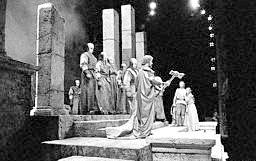
A
representation of Gods and Giants in the Valhalla (In
one of Richard Wagner’s Operas, San Francisco, U.S.A.)
|

A house
stands on shores of Jokulsa, a Fjoltum river, where the
myth of Odin’s horse Slaettur is remembered.
|
""This number," they
continued, "must have had a very ancient meaning, for it is also the
number of syllables in the Rigveda," the "Sacred Book of Verses" in
the Sanskrit language, in which have been recorded the Indo-European
tales of gods and heroes. Four hundred thirty-two thousand, the two
authors wrote, "goes back to the basic figure 10,800, the number of
stanzas in the Rigveda, with 40 syllables to a stanza" (10,800 x 40
= 432,000).
"Hindu traditions clearly associated the number
432,000 with the yugas or ages that Earth and Mankind had experienced. Each
caturyuga
("great yuga") was divided into four yugas or Ages whose diminishing
lengths were expressions of 432,000:
* first the Fourfold Age (4 x 432,000 = 1,728,000 years) which was
the Golden Age,
* then the Threefold Age of Knowledge (3 x 432,000 = 1,296,000
years), followed by
* the Double or Twofold Age of Sacrifice (2 x 432,000 = 864,000
years); and finally
* our present era, the Age of Discord which lasts a mere 432,000
years.
All in all these Hindu traditions envision ten eons,
paralleling the ten Sumerian rulers of the pre-Diluvial era but
expanding the overall time span to 432,000 years.
"Further expanded, such astronomical numbers based on 432,000 were
applied in Hindu religion and traditions to the kalpa, the "Day" of
the Lord Brahma. It was defined as a eon comprising twelve million devas ("Divine Years").
Each Divine Year in turn equals 360
Earth-years. Therefore, a "Day of the Lord Brahma" equaled
4,320,000,000 Earth-years - a time span very much like modern
estimates of the age of our Solar System - arrived at by
multiplications of 360 and 12.
|
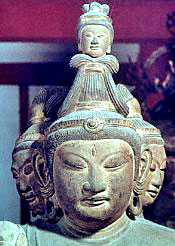
Lord Brahma,
always depicted with four Heads. |
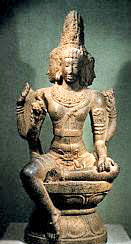 |
Mr. Sitchin continues:
4,320,000,000 is, however, a
thousandfold great yugas - a fact
brought out in the eleventh century by the Arab mathematician Abu Rayhan al-Biruni, who explained that
the kalpa consisted of 1,000
cycles of caturyugas. One could thus paraphrase the mathematics of
the Hindu celestial calendar by stating that in the eyes of the Lord
Brahma, a thousand cycles were but a single day. This brings to mind
the enigmatic statement in Psalms (90:4) regarding the Divine Day of
the biblical Lord:
A thousand years, in thy eyes,
[are] as a day past, gone by.
"....The Hindu traditions were brought to the Indian subcontinent by
"Aryan" migrants from the shores of the Caspian Sea, cousins of the
Indo-Europeans who were the Hittites of Asia Minor (today’s
Turkey)
and the Hurrians of the upper Euphrates River, through whom Sumerian
knowledge and beliefs were transmitted to the Indo-Europeans.... The
Vedas were held to be "not of human origin," having been composed by
the gods themselves in a previous age. In time the various components
of the Vedas and the auxiliary literature that derived from them
(the Mantras, Brahmanas, etc.) were augmented by the
non-Vedic Puranas ("Ancient Writings") and the great epic tales of the
Mahabarata and Ramayana. In them ages deriving from multiples of
3,600 also predominate, thus, according to the Vishnu Purana, "the
day that Krishna shall depart from Earth will be the first day of
the day of Kali; it will continue for 360,000 years of mortals."
This is a reference to the concept that the Kaliyuga, the present
age, is divided to a dawn or "morning twilight" of 100 divine years
that equal 36,000 Earth or "mortal" years, the age itself (1,000
divine years equaling 360,000 Earth-years), and a dusk or "evening
twilight" of a final 100 divine years (36,000 mortal-years) adding
up to 1,200 divine or 432,000 Earth-years.
"The depth of such widespread beliefs in a
Divine Cycle of 432,000
years, equaling 120 orbits of 3,600 Earth-years each of
Nibiru,
makes one wonder whether they represent merely arithmetical sleights
of hand - or, in some unknown way, a basic natural or astronomical
phenomenon recognized in antiquity by the Anunnaki. We have shown in
The 12th Planet, the first book of
The Earth Chronicles series, that
the Deluge was a global calamity anticipated by
the Anunnaki,
resulting by the gravitational pull of the nearing Nibiru on the
unstable ice age to an abrupt end circa 13,000 years ago, and was
thus recorded in Earth’s cycles as a major geological and climatic
change.
"....The last geological epoch, called the
Pleistocene, began about
2,500,000 years ago and ended at the time of the Deluge; it was the
time span during which:
-
hominids evolved
-
the Anunnaki came to Earth
-
Man, Homo sapiens, was brought into being
And it was during the
Pleistocene that a cycle of approximately 430,000 years was
identified in marine sediments....
Such a cyclic periodicity conforms with the
Astronomical Theory of
climatic modulations that takes into account changes due to
obliquity (the Earth’s tilt), precession (the slight orbital
retardation), and eccentricity (the shape of the elliptical
orbit)....
Mr. Sitchin includes a few more cyclic details, then he
continues:
"The "myth" of
Divine Ages thus appears to be based on scientific
facts.
"The element of Time features in the ancient records, both Sumerian
and biblical, not only as a point of beginning - "When." The
process
of creation is at once linked to the measurement of time,
measurements that in turn are linked to determine celestial
motions.... In the biblical version, it took the Lord two divine
"days" to complete the task (of creation); hopefully, even
Fundamentalists, will by now agree that these were not day and night
days as we now know them, for the two "days" occurred before Earth
had yet come into existence (and besides, let them heed the
Psalmist’s statement of the Lord’s Day being equal to a thousand
years or so). The Mesopotamian version clearly measures
Creation
Time or Divine Time by the passages of
Nibiru, in an orbit equaling 3,600 Earth-years....
"....Once the focus shifts to
Earth and ultimately to Man upon it,
the scale of Time also shifts - to an Earthly Time - to a scale
appropriate not only to Man’s abode but also to one that Mankind
could grasp and measure: Day, Month, Year.
"Even as we consider these familiar elements of
Earthly Time, it
should be born in mind that all three of them are also expressions
of celestial motions - cyclical motions - involving a complex
correlation between Earth, Moon, and Sun.
"....But such basic truths regarding the causes of the
Earthly Time
cycles of day, month, year are not self-evident and required
advanced scientific knowledge to be realized. For the better part of
two thousand years it was believed, for example, that the day-night
cycle resulted from the circling of Earth by the Sun; for from the
time of Ptolemy of Alexandria (second century A.D.) until the
"Copernican Revolution" in 1543 A.D., the unquestionable belief was
that the Sun, the Moon, and the visible planets were circling the
Earth, which was the center of the universe.
|
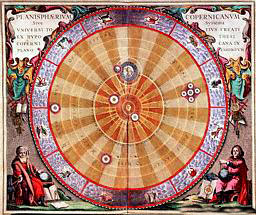
Plates
illustrating the Copernican system, |

in the
Harmonia Macrocosmica Atlas |
|
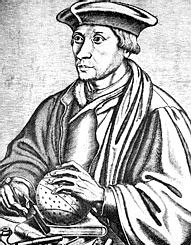
Copernicus
|
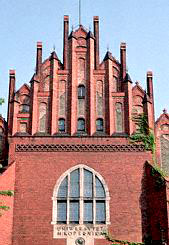
Copernicus
University |
"The suggestion by
Nicolaus Copernicus that the Sun was at the center and the Earth was
just another celestial body orbiting it, like any other planet, was
so revolutionary scientifically and heretical religiously that he
delayed writing his great astronomical work (De revolutionibus
coelestium; English translation, On the Revolutions of Celestial
Spheres) and his friends delayed printing it until his very last
day, May 24, 1543. This motions (as described in
The Enuma Elish
text) were attributed to the "destinies" (orbits) that the
Celestial
Lord (Nibiru) gave Earth and its moon as a result of the
Celestial
Battle:
The Moon he caused to shine,
to it the night entrusting;
In the night the days to signal
he appointed it, [saying:]
Monthly, without cease, form designs with a crown.
At the month’s very start, rising over the Earth,
thou shall have luminous horns to signify six days,
reaching a crescent the seventh day.
At mid month stand still opposite the Sun;
it shall overtake thee at the horizon.
Then diminish thy crown and regress in light,
at that time approaching the Sun;
And on the 30th day thou shalt stand against the Sun.
I have appointed thee a destiny; follow the path.
""Thus," the ancient text concluded, did
the Celestial Lord "appoint
the days and established the precincts of night and day."
"By listing the two luminaries (Sun and
Moon) as responsible for the
months and the days and the years, the complex lunar-solar nature of
that calendar’s antiquity (Mesopotamian-Hebrew calendar) is also
presented. Over the millennia of Mankind’s efforts to measure time
by devising a calendar, some (as the Moslems continue to this day)
have followed only the Moon’s cycles; others (as the ancient
Egyptians and the Common Era calendars in use in the Western world)
have adopted the solar year, conveniently dividing it into "months."
But the calendar devised about fifty-eight hundred years ago in
Nippur (Sumer’s religious center) and still adhered to by
the Jews
retained the biblically stated complexity of time-keeping based on
the orbital relationship between the Earth and the two luminaries.
"....Scholars have been puzzled by the fact that the
Zo’har (The
Book of Splendor), an Aramaic-Hebrew composition which is a central
work in the literature of Jewish mysticism known as Kabbalah,
unmistakably explained - in the thirteenth century of the Christian
era - that the cause of the day’s changing into night was the
turning of the Earth around its own axis.... The Zo’har’s source was
the third century Rabbi Hamnuna!
"....Such advanced knowledge, seemingly ahead of its time, can be
explained only by the retention of the earlier sophisticated
knowledge that permeates the Bible and its earlier Sumerian sources.
Indeed, Kabbalah literally means "that which was received," earlier
secret knowledge transmitted from generation to generation.... The
Talmud, recording such data and commentaries from about 300 B.C. to
about A.D. 500, is replete with astronomical snippets...." among
them the Comet Halley is mentioned as "a star which appears once in
seventy years and confounds the mariners."
Mr. Sitchin continues "Rabbi Gamliel of Jabneh possessed a tubular
optical instrument with which he observed the stars and planets -
fifteen centuries before the "official" invention of the telescope.
|
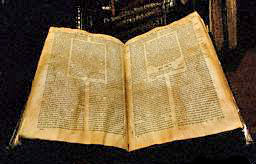
Old Jewish
Talmud |
"The need to know the
heavenly secrets stemmed from the lunar-solar nature of the Jewish
(i.e. Nippurian) calendar, which required a complex adjustment -
"intercalation" - between the solar year and the lunar year, the
latter falling short of the former by 10 days, 21 hours, 6 minutes
and about 45.5 seconds. That shortfall equals 7/19 of a synodic
month, and, therefore, a lunar year can be realigned with the solar
year by adding seven lunar months to every nineteen solar years.
Astronomy books credit the Athenian astronomer Meton (circa 430
B.C.) with the discovery of this nineteen-year cycle; but the
knowledge in fact goes back millennia, to ancient Mesopotamia.
"....In the purely lunar calendars, as is still the case in the
Moslem calendar, the holidays keep slipping back by about a month
every three years. The Nippurian calendar, having been devised to
maintain a cycle of holidays connected with the seasons, could not
allow such an ongoing slippage: the New Year, for example had to
begin on the first day of spring. This required, from the very
beginning of Sumerian civilization, a precise knowledge of the
motions of the Earth and the Moon, and their correlation with the
Sun and thus the secrets of intercalation. It also required
understanding how the seasons come about.
"....The discovery of the
solstices has also been attributed to Meton and his
colleague, the Athenian Euctemon. But in fact such
knowledge goes back to much earlier times. The rich astronomical
vocabulary of the Talmud had already applied the term
Neti’yah (from
the verb Natoh, "to tilt, inclined turn sideways") to the modern
equivalent term "obliquity" a millennium earlier the Bible
recognized the notion of the Earth’s axis by attributing the
day-night cycle to a "line" drawn through the Earth (Psalms 19:5);
and the Book of Job, speaking of the formation of the Earth and its
mysteries, attributed to the Celestial Lord the creation of an
inclined line, a tilted axis, for the Earth (Job 38:5). Using the
term Natoh, the book of Job refers to the Earth’s tilted axis and
the North Pole when it states:
He tilted north over the void
and hangeth the Earth upon nothing at all.
"If a line is drawn between the sunrise and sunset points for each
solstice, the result is such that the two lines cross above the
viewer’s head, forming a giant x that divides the Earth, and the
skies above it, into four parts. This division has been recognized
in antiquity and is referred to in the Bible when it speaks of the
"four corners of the Earth" and the "four corners of the skies." The
resulting division of the circle of the Earth and the skies in four
parts that look like triangles rounded at their bases created for
the ancient peoples the image of "wings." The Bible thus spoke of
the "four wings of the Earth" as well as of the "four wings of the
skies."
"A Babylonian map of the Earth, for the first millennium B.C.,
illustrated this concept of four "corners of the Earth" by literally
depicting four "wings" attached to the circular Earth.
"....The fourfold division of the solar year (two solstices, two
equinoxes) was combined in antiquity with the lunar motions to
create the first known formal calendar, the lunar-solar calendar of
Nippur. It was used by the Akkadians,
Babylonians, Assyrians, and
other nations after them, and remains in use to this very day as the
Jewish calendar.
"For Mankind,
Earthly Time began in 3760 B.C.; we know the exact
date because in the year 1992 of the common Era, the Jewish calendar
counts the year 5752.
"Between Earthly Time and Divine Time there is Celestial Time.
"From the moment Noah stepped out of the ark, needing reassurance
that the watery end of all flesh would not soon recur, Mankind has
lived with a lingering notion - or is it a recollection? - of cycles
or eons or Ages of Earth’s destruction and resurrection, and has
looked to the heavens for celestial signs, omens of good or bad to
come.
"From its Mesopotamian roots the Hebrew language retains the term
Mazal as meaning "luck, fortune" which would be either good or bad.
Little is it realized that the term is a celestial one, meaning
zodiac house, and harkens back to the time when astronomy and
astrology were one and the same, and priests atop temple-towers
followed the movements of the Celestial Gods to see in which house
of the zodiac - in which Manzalu, in Akkadian - they stood that
night.
"But it was not Man who had first grouped the myriads of stars into
recognizable constellations, defined and named those that spanned
the ecliptic, and divided them into twelve to create the twelve
houses of the zodiac. It was the Anunnaki who had conceived of that
for their own needs; Man adopted that as his link, his means to
ascent, to the heavens from the mortality of life on Earth.
"....It is evident from the
Sumerian King Lists and other texts
dealing with the affairs of the Anunnaki that for a long time -
certainly until the Deluge - they retained the sar,
the 3,600
Earth-years of Nibiru, as the divine unit of time. But what could
they do somehow to create a reasonable relationship, other than
1:3600, between that Divine Time and the Earthly Time.
"The solution was provided by the phenomenon called
precession."
At this point Mr. Sitchin gives more details of
measurements of
Time, followed by a quote from the mythologist Joseph Campbell:
"By a miracle that I have found no one to interpret, the arithmetic
that was developed in Sumer as early as c. 3200 B.C., whether by
coincidence or by intuitive induction so matched the celestial order
as to amount in itself to a revelation." The "miracle" as we have
since shown, was provided by advance knowledge of the Anunnaki.
"Modern astronomy, as well as modern exact sciences owes much to the
Sumerian "firsts."
After more interesting calculations quoted from various
mathematicians, Mr. Sitchin reaches to the change of zodiacal house:
"....we have been in the "Age" (or zodiac) of
Pisces since about 60
B.C., and slowly but surely we will soon enter the Age of Aquarius.
It is such a shift - the change from a fading zodiacal age - to the
start of another zodiacal age - that is the coming of a New Age.
"As Mankind on Earth awaits the change with anticipation, many are
those who wonder what the change will bring with it - of what Mazal
with it be a harbinger? Bliss or upheavals, an end - or a new
beginning? The end of the Old Order or the start of a New Order on
Earth, perhaps the prophesied return of the Kingdom of Heaven on
Earth?
"Does Time only flow forward or can it flow backward, philosophers
have wondered. In fact, Time does shift backward, for that is the
essence of the phenomenon of precession: the retardation of Earth’s
orbit around the Sun that causes, once in about 2,160 years, the
observance of sunrise on the spring equinox not in the next zodiacal
house but in the preceding one ... Celestial Time, as we have
designated it, does not progress in the direction of Earthly (and
all Planetary) Time, counterclockwise; rather, it moves in the
opposite direction, matching the orbital (clockwise) direction of
Nibiru.
"Celestial Time does flow backward, as far as we on Earth are
concerned; and therefore, in zodiacal terms, the Past is the Future.
"Let us examine the Past.
Return
Chapter Two
A COMPUTER MADE
OF STONE
|
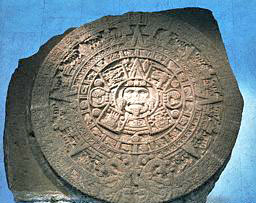
Calendar
Stone |
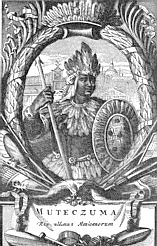
Moctezuma
|
"....When Hernando
Cortes was welcomed by the Aztec king Moctezuma as a returning god,
he was presented with an immense golden disk on which were carved
the symbols of the cyclical ages in which the Aztecs and their
predecessors in Mexico believed. That precious artifact has been
lost forever, having been quickly melted down by the Spaniards; but
replicas thereof, in stone, have been found. The glyphs represented
cycles of the "Suns" or ages of which the present is the fifth.
*
the first age was the Age of the White Haired Giants
* the second, the Golden Age
*
the third was the Age of the Red Haired People (who,
according to the legends, were the first to arrive by ships
in the Americas)
* the fourth was the Age of the Black Haired People, with whom
the supreme Mexican god, Quetzalcoatl, had arrived
"All the way south in the pre-Columbian
Peru, the Andean people also
spoke of five "Suns" or ages.
* the first one was the
Age of the Viracochas, white and bearded gods
*
the second was the Age of the Giants
*
followed by the Age of Primitive Man
* the
fourth was the Age of Heroes
* the fifth or contemporary age, the
Age of Kings, of
which the Inca kings were the last in line
"....The city of
Cuzco itself, it appears, was (in the words of S.
Hagar in a paper delivered at the 14th Congress of Americanists) "a
testimonial in stone" to the South American familiarity with the
twelve-house zodiac. The unavoidable conclusion is that knowledge of
the zodiacal division of the ecliptic was somehow in the New World
millennia ago, and that the ages were measured in the 2,160-year
units of Celestial Time.
"The idea that calendars could be made of stone might seem strange
to us, but it was evidently quite logical in antiquity. One such
calendar, posing many puzzles, is called Stonehenge.... in
England,
north of the city of Salisbury and about eighty miles southwest of
London.... Time, we believe, is the key to its secrets.
|
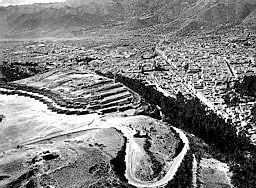 |
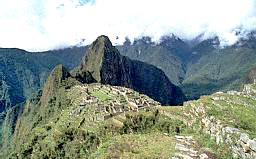
View of the
City of Cuzco, from the Fortress of Sacsahuaman, left.
Machu Picchu, in the highlands of Cuzco, above.
|
|

Two views of
Stonehenge |
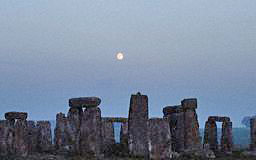
|
"Stonehenge has been
called "the most important prehistoric monument in the whole of
Britain," and that alone justifies the attention it has been given
over the centuries and especially in recent times.... Stonehenge is
indeed the largest and most elaborate of more than nine hundred
ancient stone, wood and earthern circles in the British Isles, as
well as the largest and most complicated one in Europe.
"Yet, in our view, it is not only what makes
Stonehenge unique that
is its most important aspect. It is also what reveals its similarity
to certain monuments elsewhere, and its purpose at the specific time
of its construction, that make it part of the tale we have called
The Earth Chronicles. It is within such a wider framework, we
believe, that one can offer a plausible solution to its enigma.
"Even those who have not visited Stonehenge must have seen, in print
or on the screen, the most striking features of this ancient
complex: the pair of huge upright stone blocks, each about thirteen
feet high, connected at the top by an equally massive lintel stone
to form freestanding Trilithons; and these, erected in a semicircle,
surrounded in turn by a massive circle of similar giant stones
connected at the top by lintels that were carefully carved to form a
continuous ring around the paired uprights.
Mr. Sitchin at this point gives more details of the stones of
Stonehenge, the number of stones that were supposed to have existed
on site and other. He continues further:
"As if to emphasize the
importance of the circular shape already evident, the ring of stones
are in turn centered within a large framing circle. It is a deep and
wide ditch whose excavated soil was used to raise its banks; it
forms a perfect encompassing ring around the whole Stonehenge
complex, a ring with a diameter in excess of three hundred feet.
Approximately half the circuit of the ditch was excavated earlier
this century and then partly refilled; the other portions of the
ditch and its raised banks bear marks of being weathered down by
nature and man over the millennia
|
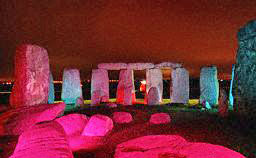
Night view
through the megaliths of Stonehenge, toward the "Heel
Stone," marking the position of the rising Sun on the summer
solstice. This photo has been enhanced with artificial
lights. |
"....The concentric
circles of Stonehenge with the Avenue (Mr. Sitchin explains at
length this feature in his book) leading to the northeast provide a
major clue regarding the purpose for which Stonehenge was
constructed. That the direction of the Avenue - its precise
northeastern orientation - was not accidental becomes learned when
it is realized that a line drawn through the center of the Avenue
passes through the center of the circles of stones and wholes to
form the structure’s axis. That the axis was deliberately oriented
is suggested by a series of holes indicating that the marker stones
had once been placed along this axis. One of them, called the Heel
Stone, still stands as a mute witness to the builders’ intentions
and the site’s purpose; it was undoubtedly astronomical.
"The idea that
Stonehenge was a carefully planned astronomical
observatory rather than a heathen cult or occult site (a notion
expressed, for example, by calling a fallen stone "Slaughter Stone,"
implying human sacrifices), was not easily accepted. In fact, the
difficulty grew rather than diminished the more the site was
investigated and its date of construction kept shifting backward.
"A twelfth-century account (Historia regum Britanniae by
Geoffrey of
Monmouth) related that the "Giants’ Ring" was "a stone cluster which
no man of the period could ever erect and it was first built in
Ireland from stones brought by the giants from Africa." It was then
by the advice of the sorcerer Merlin (whom Arthurian legends also
connected with the Holy Grail) that the King of Vortigen moved the
stones and "re-erected them in a circle round a sepulchre, in
exactly the same way as they had been arranged on Mount Killaraus,
in Ireland. (That this medieval legend had a factual core was given
confirmation by the modern discovery that the blue stones originated
from the Prescelley Mountains in southwestern Wales and were somehow
transported by land and water over a distance of two hundred fifty
miles - first to a site some twelve miles northwest of Stonehenge,
where they might have been erected in an earlier circle, and then on
to Stonehenge proper).
The Arthurian
legends were involved in Stonehenge...
|
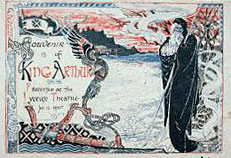
A color
souvenir for the 1895 production of "King Arthur," at
the Lyceum Theatre, featuring Merlin the Wizard. King
Arthur at right. |
 |
|

The Welsh
hill from where the massive stones
for the
Stonehenge monument came from |
"The stone temple was
attributed to the Romans, the Greeks, the Phoenicians, or the
Druids.... Of these various theories, the one concerning the Druids
gained the most favour at the time (seventeenth, eighteenth
centuries), not least of all because of the research and writings of
William Stukely, especially his 1740 work Stonehenge, A Temple Restor’d To The British Druids. The
Druids were the learned class or
sect of teacher-priests among the ancient Celts. According to
Julius
Caesar, who is the prime source of information regarding the
Druids,
they assembled once a year at a secret place for secret rites; they
offered human sacrifices; and among the subjects they taught the
Celt noblemen were "the powers of the gods," the sciences of nature,
and astronomy....
|
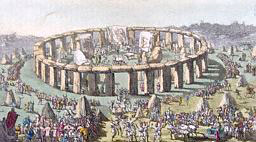
19th Century
depiction of Druids at Henge, Brittany (above)
Druids perform a summer solstice ceremony within the
ring of Trilithons (right) |
 |
|

Acting in
the production of "Julius Caesar," 1898, California.
"He had much information regarding the Druids".
|
"While nothing that has
been uncovered by archaeologists at the site reveals any connection
with pre-Christian era Druids, the Celts had arrived in the area by
that time and there is no proof the other way either, namely that
the Druids did not gather at this "Sun Temple" even if they had
nothing to do with its much earlier builders.
"Although Roman legions encamped near the site, no evidence was
found to connect Stonehenge with the Romans. A
Greek and Phoenician
connection, however, shows more promise. The Greek historian Diodorus Siculus (first century B.C.) - a contemporary of
Julius
Caesar - who had traveled to Egypt wrote a multivolume history of
the ancient world.
"....Drawing on the writings of earlier historians, he quotes from a
(by now lost) book by Hecatacus of Abdea, in which the latter had
stated, circa 300 B.C., that on an island inhabited by the
Hyperborians "there is a magnificent sacred precinct of
Apollo and a
notable temple which is spherical in shape." The name in Greek
signified a people from the distant north, where the north wind ("Boreas")
comes. They were worshippers of the Greek (later Roman) god Apollo,
and the legends regarding the Hyperboreans were thus mingled with
the myths concerning Apollo and his twin sister, the goddess
Artemis. As the ancients told the twins were the sons of the great
god Zeus and their mother Leto, a Titaness....
Leto wandered over
the face of the Earth seeking a place where to give birth to her
children in peace, away from the wrath of Hera, the official wife of
Zeus.
|
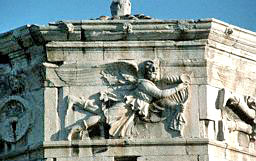
Sculpture of
"Boreas" on The Tower of Winds (above)
Temple of
Artemis at Ephesus (right) |
 |
|
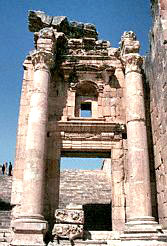
Gate of
Temple of Artemis; Jerash, Jordan |
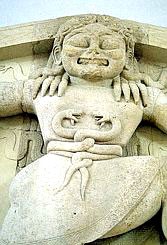
Detail of
Artemis, from Archaic Temple at Kerkira.
|
|
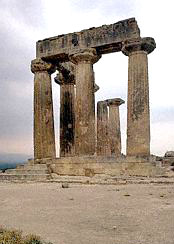
Temple of
Apollo at Corinth |
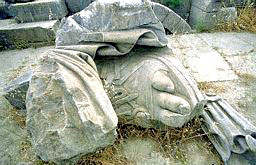
From Temple
of Apollo at Klaros: a ruined foot of Artemis
|
|

Ruins of
Temple of Hera, at Olympia, Greece |

Arches over
doorway of Temple of Zeus.
Jerash, Jordan |
"....Though not
attributing any scientific value to such a legendary or mythological
connection with Greece, archaeologists have nevertheless seemed to
find such a connection through archaeological discoveries in the
area of Stonehenge, which is replete with prehistoric earthworks,
structures and graves. These man-made ancient remains include the
great Avebury Circle which schematically drawn resembles the works
of a modern watch, or even the meshing wheels of the ancient Mayan
calendar.
|

Standing
Stones at Averbury Circle |
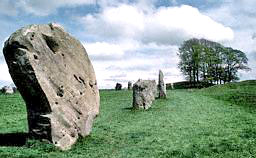
. |
"The ancient remains
found also include the miles long trench called the Cursus; a kind
of wooden-peg rather than stone-made circle called Woodhenge; and
the outstanding Silbury Hill - an artificial conical hill which is
precisely circular and 520 feet in diameter, the largest of its kind
in Europe (some see significance in the fact that it is situated an
exact six purported "megalithic miles" from Stonehenge).
|
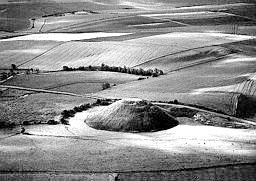
Silbury Hill,
Wiltshire, England |
"....Many of those finds
reinforced archaeological opinions that the manner in which stones
at Stonehenge were smoothly dressed and carefully shaped indicated
"influences" from Minoan Crete (the Mediterranean island) and
Mycenaean (mainland) Greece.
"....A leading representative of this school has been
Jacquetta
Hawkes, who in her book, Dawn of the Gods, about the Minoan and
Mycenaean origins of Greek civilization, could not help devoting a
good portion of the chapter on "Graves and Kingdoms" to
Stonehenge.... It flowered in the sixteenth century B.C. and the
treasures uncovered in the tombs of its kings revealed foreign
contacts that undoubtedly included Britain.
|

Grave Circles at
Mycenae |
"....Not all
archaeological finds, however, showed such early Greek "influences."
The finds in tombs around Stonehenge included, for example,
decorated beads and amber disks bound with gold in a method
developed in Egypt and not at all in Greece. Such finds raised the
possibility that all those artifacts were somehow imported to
southeast England, neither by Greeks nor Egyptians but perhaps by
trading people from the eastern Mediterranean. The obvious
candidates were the Phoenicians, the renowned sailors-cum-traders of
antiquity.
"It is a recorded fact that the Phoenicians, sailing from their
Mediterranean ports, reached Cornwall in the southwest corner of
England, quite close to Stonehenge, in the search for tin, with
which hardened bronze was made from soft copper. But were any of
these peoples, whose trade links flourished in the millennium
between 1500 B.C. and 500 B.C., responsible for the planning and
construction of Stonehenge? Did they even visit it? A partial answer
would depend of course, on when Stonehenge itself was conceived and
built, or who else was there to build it.
"....Subjected to radiocarbon dating, remains found in
the Ditch
(Stonehenge) produced a date in between 2900 to 2600 B.C. - at least
a thousand years and probably much more before the sailors from the
Mediterranean might have arrived. A charcoal piece found in one of
the Aubrey Holes provided a carbon date of 2200 B.C.; an
anther pick
found near one of the trilithons gave a reading of between 2280 and
2060 B.C.; radiocarbon datings of finds in the Avenue gave dates
between 2245 and 2085 B.C.
"Who was there at such an early time to plan and execute the
marvelous stone complex?
"....Were the Neolithic
farmers and herders (about 3000 B.C.), the
Beaker People (some time after 2500 B.C. and so called because of
the shape of their drinking vessels), or even the Early Bronze Age Wessex People (2000 B.C.) capable of creating
Stonehenge? or did
they just provide the labor and the manpower to construct a complex
mechanism in stone devised by advanced scientific knowledge of
others?
"Even an outspoken proponent of the Mycenaean connection,
Jacquetta
Kawkes, had to admit that Stonehenge.... (among other facts).... "It
has always seemed that some individual must have initiated it -
through swollen ambition or religious obsession - but because the
whole design and method of building is so far advanced of anything
known in the island before, it has seemed likely that ideas drawn
from a more civilized tradition might also have been involved."
"But what was that "more civilized tradition" that gave rise to this
structure that was beyond compare to anything in prehistoric Europe?
The answer must depend on an accurate dating of Stonehenge; and if,
as scientific data suggests, it is a thousand to two thousand years
older than the Mycenaeans and the Phoenicians, then an earlier
source of the "civilized tradition" must be sought. If
Stonehenge
belongs to the third millennium B.C., then the only candidates are
those of Sumer and Egypt. When Stonehenge was first conceived, the
Sumerian civilization, with its cities, high-rise
temples-cum-observatories, writings, and scientific knowledge, was
already a thousand years old, and kingship had already flourished in
Egypt for many centuries.
"For a better answer, we have to put together the knowledge
accumulated by now regarding the several phases by which Stonehenge,
according to the latest research, came to be.
Mr. Sitchin explains amply in his book, the "phases" in which
Stonehenge was built, they were:
* Stonehenge I
= The Ditch and its embankment,
- The 56 Aubrey Holes,
- Two "gateway stones," focusing aids to the Heel Stone,
- The Post Holes, may have been intended to hold wooden markers,
- The four rounded Station Stones.... to form a perfect rectangle.
- This phase scholars suggest it was constructed between 2900 and
2600 B.C.
"Whoever constructed Stonehenge I, and for whatever purpose, found
it satisfactory for several centuries."
* Stonehenge II = At about 2100 B.C., the main event was:
- The introduction of the blue stones, making Stonehenge II a stone
"henge" for the first time. What ever the precise route was to haul
the bluestones, it is believed that in the end they were brought to
the site’s proximity up the River Avon, which explains why the
Avenue was extended by some two miles at this phase to connect
Stonehenge with the river.
- The so called Altar Stone, was erected within the circles exactly
on the Stonehenge axis, facing
- The Heel Stone to the northeast. "But as the researchers checked
the alignment and the position of the outer stones, they discovered
to their surprise that the Heel Stone was shifted in this Phase II
somewhat eastward (to the right, as one looks from the enclosure’s
center); simultaneously, two other stones were erected in a row in
front ot the Heel Stone, so as to emphasize the new line of sight.
"Unexpectedly, the researchers realized that the main innovation of
Stonehenge II was not the introduction of the blue stones, but
- The introduction of a new axis, an axis somewhat more to the east
than the previous one.
* Stonehenge III = Followed Phase II within decades.
"Whoever was in charge decided to give the complex (Stonehenge) a
monumental scope and permanence. It was then that Phase III was
added:
* The huge sarsen stones.... were hauled to Stonehenge from
Marlboro
Downs, some twenty miles away.... even more daunting must have been
the task of setting them up.... and then all those prepared (dressed
to the desired shapes) stones had to be erected in a precise circle
or in pairs, and the holding lintels hauled up to be placed on top.
How the task, made more difficult by the site’s slope, was achieved,
no one really knows.
- Two new Gateway Stones, replaced the old ones.
- The Sarcen Circle and the Trilithon Horseshoe, or oval....
- The inner Bluestone Horseshoe, and the Bluestone Circle (from the
old bluestones).
"....In the usual course of scientific studies of ancient sites,
archaeologists are the first to be on the scene.... and others
experts - follow. In the case of Stonehenge, astronomers led the
way. This was not only because the ruins were visible above the
surface and required no excavation to reveal them, but also because
from the very beginning it seemed almost self-evident that the axis
line from the center toward the Heel Stone through the Avenue
pointed "to the northeast, whereabouts the Sun rises when the days
are longest" (to use the words of William Stukeley, 1740) - toward
the point in the sky where the Sun rises at the summer solstice
(about June 21). Stonehenge was an instrument to measure the passage
of time!
"After two and an half centuries of scientific progress, this
conclusion is still valid. All are agreed that Stonehenge was not a
place of residence; nor was it a burial place. Neither palace nor
tomb, it was in essence a temple-cum-observatory, as the ziggurats
(step-pyramids) of Mesopotamia and ancient America were. And being
oriented toward the Sun when it rises in midsummer, it could be
called a Temple of the Sun.
"....Since this orientation is satisfied by the axis alone,
subsequent researchers began in time to wonder whether the
additional complexity of Stonehenge - the diverse circles, ovals,
rectangle, markers - might signify that other celestial phenomena
besides sunrise at summer solstice and other time cycles have been
observed at Stonehenge.... It was only in 1963, when
Cecil A. Newham
discovered alignments that suggested that equinoxes too could have
been observed and even predicted at Stonehenge, that these
possibilities were given modern scientific credence.
"His most sensational suggestion, however.... was that
Stonehenge
must have also been a lunar observatory....
"....Prominent among the astronomers whose investigations confirmed
the incredible capabilities of Stonehenge was Gerald S. Hawkins of
Boston University. Writing in prestigious scientific journals in
1963, 1964, and 1965.... With the aid of the university’s computers
he analyzed hundreds of sight lines at Stonehenge and related them
to the positions of the Sun, Moon, and major stars as they were in
ancient times, and decided that the resulting orientations could not
have been just accidental.
These paragraphs (in the book) also include the
calculations of
Lunar cycles, bringing in the important cycle of "19 years," which
makes the position of Stonehenge with all its features perfect for
measuring celestial time.
"....The proposition that
Stonehenge was not only a "Sun temple" but
also a lunar observatory, was met at first with fierced
resistance....
"Thom, an engineering professor at Oxford University, conducted the
most accurate measurements at Stonehenge, and pointed out that the
"horseshoe" arrangement of the sarcen stones in fact represented an
oval, and elliptical shape that represents planetary orbits more
accurate than a circle. He agreed with Newham that Stonehenge I was
primarily a lunar, and not just a solar observatory, and confirmed
that Stonehenge was erected where it is because it is only there
that the eight lunar observations could be made precisely along the
lines formed by the rectangle connecting the four Station Stones.
"....Newham summed up: "With the exception of the five
Trilithons,
practically all the remaining features appear to have lunar
connections." He agreed that the "56 Aubrey Holes rotate to the
eight main alignments of the Moon setting and rising." Thereafter,
even Atkinson ( a previous dissenter) admitted that he "has become
sufficiently persuaded that conventional archaeological thinking is
in need of drastic revision" in regard to the purpose and functions
of Stonehenge.
"....Notable participant.... of the 1960s and the decade of the
1970s, Sir Fred Hoyle, astronomer and mathematician, held that the
alignments listed by Hawkins to various stars and constellations
were rather random than deliberate, but fully agreed with the lunar
aspects of Stonehenge I - and especially the role of the fifty-six
Aubrey Holes and the rectangular arrangement of the
Station Stones
("Stonehenge - An Eclipse Predictor" in Nature and On Stonehenge).
"But concurring that the Aubrey Circle could act as a "calculator"
for predicting eclipses (in his opinion it was done by moving four
markers around), Hoyle stirred up another issue. Whoever had
designed this calculator - Hawkins called it a "computer" - must
have known in advance the precise length of the solar year, the
Moon’s orbital period, and the cycle of 18.61 years; and
Neolithic
Man in Britain simply did not possess such knowledge.
"Struggling to explain how the advanced knowledge of astronomy and
mathematics had appeared in Neolithic Britain, Hawkins resorted to
ancient records of the Mediterranean peoples. In addition to the Diodorus/Hecatacus reference he also mentioned
Plutarch’s quote (in
Isis and Osiris) of Eudoxus of Cnidus the fourth century B.C.
astronomer-mathematician from Asia Minor who had associated the
"demon god of eclipses" with the number fifty-six.
"In the absence of answers from
Man, a glance at the superhuman?
"Hoyle on his part, arrived at the conviction that
Stonehenge was
not a mere observatory, a place to see what goes on in the sky. He
called it a Predictor, an instrument for
foretelling celestial events
and a facility for noting them on the predetermined dates.... he
felt that the Station Stones rectangle and all it implied indicate
"that the builders of Stonehenge I might have come to the British
Isles from the outside, purposely looking for this rectangular
alignment" (which is possible why Stonehenge is located, in the
northern hemisphere)....
"...."A veritable Newton or
Einstein must have been at work at
Stonehenge," Hoyle mused; but even so where was the university where
he had learned mathematics and astronomy, where were the writings
without which accumulated knowledge could not be passed on and
taught, and how could a sole genius plan, execute and supervise such
a celestial predictor when for Phase II alone, a whole century was
needed? "There have only been about 200 generations of history;
there were upward of 10,000 generations of prehistory," Hoyle
observed. Was it all part of the "eclipse of the gods," he wondered
- the transition from a time when people worshiped an actual Sun god
and a Moon god "to become the invisible God of Isaiah?"
"....The familiarity in such distant times not only with the
nineteen-year cycle of the Moon but also with "prominences" (as
mentioned in Diodorus from Hecatacus regarding the
Hyperborians),
like those of the Earth" - surface features such as mountains and
plains - is unquestionably amazing.
"The attribution by Greek historians of the circular structure in
Hyperborea to the lunar cycle first described in Greece by the
Athenian Meton tosses the problem of Who Built Stonehenge to the
ancient Near East; so do the soul-searching conclusions and musings
of the above mentioned astronomers.
"But more than two centuries earlier,
William Stukeley had already
pointed for answers in the same direction, toward the ancient Near
East. To his sketch of Stonehenge, as he understood it to have been,
he appended the design he had seen on an eastern Mediterranean
ancient coin, which depicts a temple on an elevated platform. This
depiction, more explicit, also appears on another ancient coin from
the city of Byblos in the same area.... It shows that the ancient
temple had an enclosure in which there stood a rocket upon a launch
pad. We have identified the place as The Landing Place of Sumerian
lore, the place where the Sumerian king Gilgamesh witnessed a
rocket
ship rise. The place still exists; it is now the vast platform in
the mountains of Lebanon, at
Baalbeck, upon which there still stands
the ruins of the greatest Roman temple ever built. Supporting the
massive platform are three colossal stone blocks that have been
known since antiquity as the Trilithon.
(below image)

"The answers to the
Stonehenge enigma should thus be sought in
places far away from it, but in a time frame quite close to it. The
When holds the key, we believe, not only to the Who of Stonehenge I,
but also to the Why of Stonehenge II and III.
For, as we shall see, the hurried remaking of
Stonehenge in 2100 -
2000 B.C. had to do with the coming of a New Age - Mankind’s first
historically recorded New Age.
Return
|















